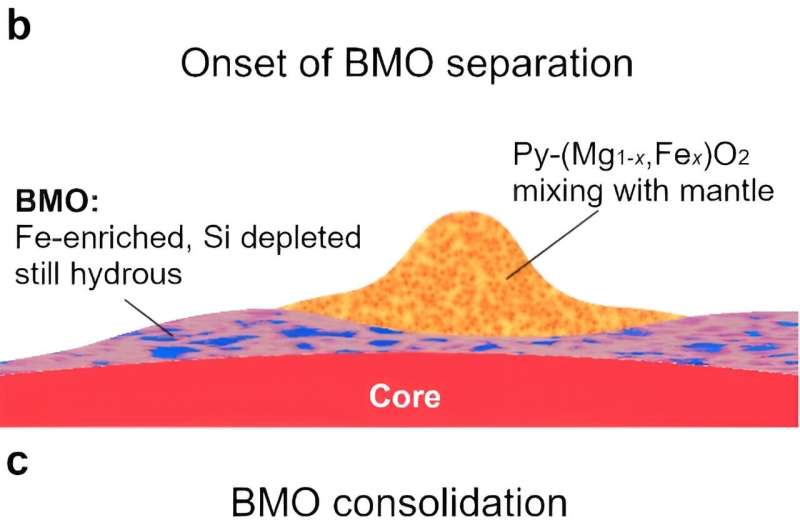This article has been reviewed according to Science X's editorial process and policies. Editors have highlighted the following attributes while ensuring the content's credibility:
fact-checked
trusted source
proofread
Earth's mysterious D" layer: A relic of ancient oceans and planetary collisions

Deep within Earth, there lies a mysterious layer called the D" layer. Located roughly 3,000 kilometers down, this zone sits just above the boundary between the planet's molten outer core and its solid mantle.
Unlike a perfect sphere, the D" layer is surprisingly patchy. Its thickness varies greatly from place to place, with some regions even lacking a D" layer altogether—much like continents rise above the Earth's oceans. These intriguing variations have captured the attention of geophysicists, who describe the D" layer as a heterogeneous, or non-uniform, region.
A new study led by Dr. Qingyang Hu (Center for High Pressure Science and Technology Advanced Research) and Dr. Jie Deng (Princeton University) suggests the D" layer might have originated from Earth's earliest days. Their theory hinges on the Giant Impact hypothesis, which proposes a Mars-sized object slammed into the proto-Earth, creating a planet-wide magma ocean in the aftermath. They believe the D" layer may be a unique composition leftover from this colossal impact, potentially holding clues to Earth's formation.
The paper is published in the journal National Science Review.
Dr. Jie Deng highlights the presence of a substantial amount of water within this global magma ocean. The exact origin of this water remains a topic of debate, with various theories have been proposed including its formation through reactions between nebula gas and the magma, or direct delivery by comets.
"The prevailing view," Dr. Deng continues, "suggests that water would have concentrated towards the bottom of the magma ocean as it cooled. By the final stages, the magma closest to the core could have contained water volumes comparable to Earth's present-day oceans."
The extreme pressure and temperature conditions within the bottom magma ocean would have created a unique chemical environment, fostering unexpected reactions between water and minerals. Dr. Qingyang Hu explains, "Our research suggests this hydrous magma ocean favored the formation of an iron-rich phase called iron-magnesium peroxide."
This peroxide, with the formula (Fe,Mg)O2, has even stronger preference to iron compared to other major components expected in the lower mantle. "According to our calculation, its affinity to iron could have led to the accumulation of iron-dominant peroxide in layers ranging from several to tens of kilometers thick," the researchers add.
The presence of this iron-rich peroxide phase would alter the mineral composition of the D" layer, deviating from our current understanding. According to the new model, minerals in D" would be dominated by a new assemblage: the iron-poor silicate, iron-rich (Fe, Mg) peroxide, and iron-poor (Fe, Mg) oxide.
This iron-dominant peroxide also possesses low seismic velocities and high electrical conductivity, making it a potential candidate to explain the D" layer's unique geophysical features. These features include ultra-low velocity zones and layers of high conductance, both contributing to the D" layer's well-known compositional heterogeneity.
"Our findings suggest that iron-rich peroxide, formed from the ancient water within the magma ocean, has played a crucial role in shaping the D" layer's heterogeneous structures." said Qingyang. This peroxide's strong affinity for iron creates a stark density contrast between these iron-rich patches and the surrounding mantle.
Essentially, it acts as an insulator, preventing them from mixing and potentially explaining the long-lasting heterogeneity observed at the base of the lower mantle. Jie added, "This model aligns well with recent numerical modeling results, suggesting the lowermost mantle's heterogeneity may be a long-lived feature."
More information: Qingyang Hu et al, Earth's core-mantle boundary shaped by crystalizing a hydrous terrestrial magma ocean, National Science Review (2024). DOI: 10.1093/nsr/nwae169
Provided by Science China Press





















